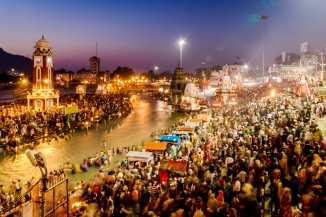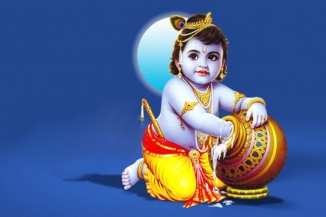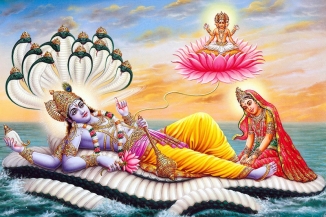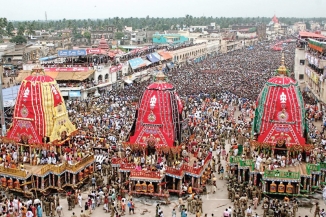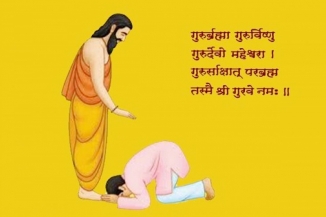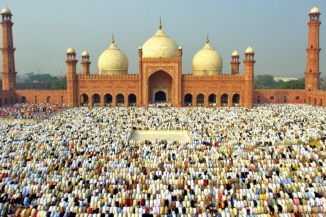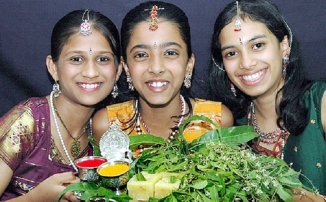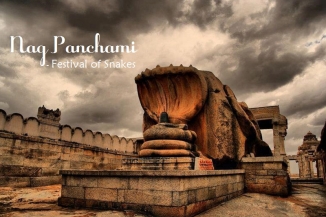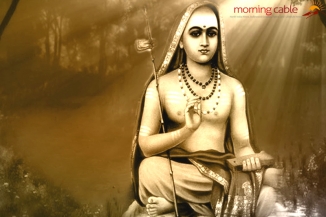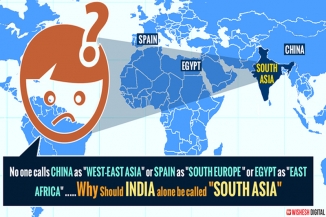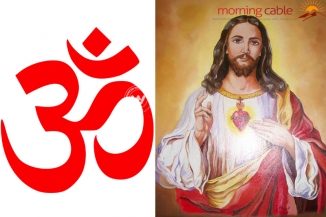
The legend behind the birth of Lord Ganesha tells that Parvathi, the consort of Shiva, created Ganesha out of sandalwood paste that she has used for her bath and breathed life into it. She then set him the task of guarding the door while she bathed. Shiva, who had gone out, returned and as Ganesha didn't know him, didn't allow him to enter. This raised a combat between Shiva ganas and Ganesha. Seeing that the combat was lost by Shiva Ganas, Shiva got angry and severed the head of the child. Parvathi seeing this became enraged and Shiva then promised that her son will be alive again. The devas searched for the head of a living being sleeping facing North and they found an elephant sleeping facing North. They brought the head of the elephant and Shiva fixed it on the child's body and brought him back to life.
The Linga Purana says, Ganesha was created by Lord Shiva and Goddess Parvati at the request of the Devas for being a Vighnakartaa (obstacle-creator) in the path of Rakshasas and a Vighnahartaa (obstacle-averter) to help the Devas to achieve fruits of their hard work.
The festival os Vinayaka Chathurthi is observed in the Hindu calendar month of Bhaadrapada, starting on the shukla chaturthi, the fourth lunar day of the waxing moon fortnight.
Ganesha Chaturthi festival starts with the installation of Ganesha statues in colorfully decorated homes and specially erected temporary structures mandapas (pandals) in every locality.
The Ganesh Chaturthi of 2015 Puja Muhurut to bring the Vigraha / Idol to home is during the Shubh, Labh or Amrit Choghadiya. On the 16th September 2015, the Labh time is between 06:30 and 08:01 and the Amrit time is 08:01 and 09:32. The idol can be brought home on 17 September (Avahana or Welcome) during the Shubh time between 11:03 and 12:33. The Muhurut for evening time, the Labh time is between 17:06 and 18:37.
The Ganesh Staphna (installation of the Idol) on Ganesh Chaturthi day, i.e. on 17th September 2015 can be done at between 11:02 and 12:33 or Shubh Time i.e. between 06:30 and 08:01. Ganesh Pooja is preferred during Madhyanhana on Ganesh Chaturthi as it is believed that Lord Ganesh was born during Madhyahana Kaal which is between 12:33 and 15:35. The Muhurut time specified above is the best Muhurut to perform the Ganesh Puja and to perform any work.
Offerings to Lord Ganesha differs from state to state. Modaka, laddoos, kadubu or karanjis are the specialities offered to lord ganesha.
Ganesh Chaturthi is celebrated in the UK by the migrant Hindu population as well as the large number of Indians residing there. The Hindu culture and Heritage Society, UK, a Southall based organisation celebrated Ganesh Chaturthi for the first time in London in 2005 at The Vishwa Hindu Temple. Another celebration was organised by a Gujarati group has been celebrated in the Southend-on-Sea which attracts over 18000 devotees. Annual celebrations also take place on the River Mersey at Liverpool.
The Hindu Swayamsevak Sangh USA, an organisation of Hindus based in the US organises many such events to mark the Hindu festivals.
In USA, Ganesh Chaturthi is celebrated by various associations of people from India.
The Philadelphia Ganesh festival is the largest Sarvajanik (fully contributed by public funds) Hindu festival in North America. Since 2005 the festival is conducted every year in Bharatiya Temple, Chalfont, Pennsylvania. The 10 days are marked by processions, devotional programs, cultural events, India filmi-orchestra and a weekend carnival. The Marathi community plays a big role in organising the festival, participation from all communities such as Gujarati, Kannadigas, Tamil, Telugu, North Indian, Bengali etc. is seen.
In Canada, Ganesh Chaturthi is celebrated by associations of Marathi-speaking people.
Celebration of Ganesh Chaturthi in Mauritius dates back to 1896. The first Ganesh Chaturthi Puja was held in the 7 Cascades Valley next to Henrietta village by the Bhiwajee family who is still celebrating this pious festival after more than a century. Mauritian government has attributed a public holiday for Ganesh Chathurthi.
In Malaysia and Singapore, the festival is more commonly known as Vinayagar Chakurthi because of the relatively larger Tamil-speaking Hindu minority. Most Ganesha temples mark Vinayagar Chaturthi with morning prayers, abhishegam (ritual bathing of the deity) and free vegetarian lunch for devotees and the poor. Chariot processions organised by Ganesha temples in the evenings often attract huge crowds of devotees and tourists.
By Premji





